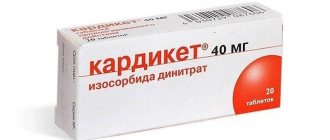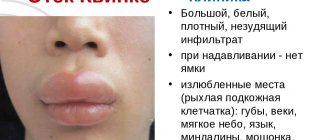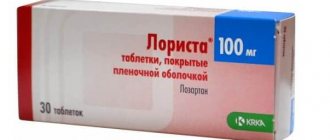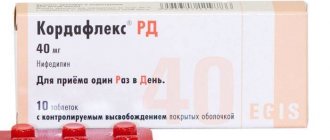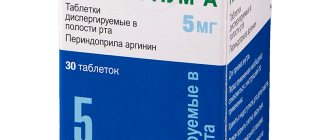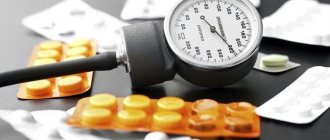Composition of the drug
The instructions for use say that this product is available in film-coated tablets, 10 pieces in one blister, 5 blisters in a box. In addition to tablets, Cordipine is also available in the form of an injection solution. The main active ingredient of the drug Cordipine is 10 mg of nifedipine. A complete list of the components of this medication according to the instructions:
- pregelatinized starch;
- povidone;
- sodium lauryl sulfate;
- anhydrous colloidal silicon dioxide;
- talc;
- lactose monohydrate;
- corn starch.
The pill shell also consists of the following components: talc, titanium dioxide, quinoline dye E104 and macrogol. All ingredients are safe for internal use.
Release form and composition
Kordipin is produced in the form of film-coated tablets (in strips of 10 pieces; 5 strips in a cardboard box).
1 tablet contains:
- Active ingredient: nifedipine – 0.01 g;
- Auxiliary components: povidone, anhydrous colloidal silicon dioxide, lactose monohydrate, pregelatinized starch, sodium lauryl sulfate, talc, corn starch.
The tablet shell contains: talc, titanium dioxide, quinoline yellow dye (E104), macrogol, methacrylic acid copolymer.
Kordipin HL
As mentioned, this product has two forms of release: CL and retard. Both options are slightly different from the regular version and are necessary to enhance the effect of the medicine. The instructions say that the form of CL Cordipin is modified-release tablets.
Unlike the standard Cordipin 10 mg, CL has 40 mg of active ingredient per piece, and additionally contains cellulose, hypromellose, lactose and magnesium stearate. Usually sold 10 or 20 pieces per pack. This type is aimed at gradual prolonged (slow) release.
Korpidin HL tablets cannot be chewed or even divided!
special instructions
At the beginning of the course of therapy, elderly people require specialist supervision, as do people with pulmonary hypertension and unstable angina. Diabetes mellitus. With coronary insufficiency, complications of myocardial ischemia are possible, which is manifested by frequent attacks of pain.
Cordipine may interfere with laboratory tests and cause false results. May have an effect on serum alkaline phosphatase, lactic acid dehydrogenase, glutamate-pyruvate transaminase, and glutamate-oxaloacetate transaminase tests. Changes in these indicators may manifest as symptoms of jaundice or cholestasis or other manifestations.
It is strictly forbidden to abruptly stop taking Cordipine, especially after a long course of treatment, so as not to provoke withdrawal syndrome.
Cordipine has side effects on the nervous system, so it is not advisable to drive vehicles or operate complex machinery during therapy.
The use of Cordipine is not compatible with alcoholic beverages, because nifedipine can cause hypotension with complications in combination with alcohol.
Cordipin retard
The second form of release is Kordipin retard, extended-release tablets. Unlike the standard Cordipine 10 mg, retard has 20 mg of nifedipine per piece. According to the instructions, the composition additionally includes magnesium stearate, glyceryl palmitostearate and microcrystalline cellulose. Usually sold in 15 or 30 pieces per pack. The use of this type involves a very slow-acting, but longer-term effect. Korpidin retard tablets cannot be chewed or even divided!
All three options, CL, retard and regular Cordipin 10, are produced by a Slovenian company specializing in pharmaceuticals - KRKA.
Overdose
If you accidentally take a larger dose, an overdose of Cordipine may occur. This condition is also possible if the dose is incorrectly calculated or if the elimination of the drug is impaired. This is possible in severe renal failure. Low metabolizing function of the liver can also lead to overdose. Symptoms of overdose are:
- severe hypotension;
- tachycardia, tachyarrhythmia;
- disorders of the digestive tract;
- weakness;
- hyperemia of the face and upper extremities;
- vestibular-atactic disorders;
- color vision disorders;
- convulsions, loss of consciousness.
Important! Side effects of nifedipine are short-term, but require seeking medical help.
To stop them, sorbents (activated carbon) are used. Symptomatic treatment is prescribed, depending on the signs of overdose. It is mandatory to stop taking the subsequent dose and lavage the stomach.
What are these pills for?
Now let's take a closer look at the standard Cordipin - what its use helps get rid of and what is the main indication. If you look at the instructions, the main indications for use are coronary heart disease and hypertension. Cordipine is used in the treatment of angina pectoris, as well as for the prevention of cardiovascular accidents in patients at risk.
Damage to the coronary arteries in coronary heart disease
Instructions for use
Before using any medicine, you must read the instructions for use. Cordipine also has complete instructions on dosage options and dosage, which describes, including under what health conditions the use of this medication is prohibited.
How to use?
The instructions describe that medication in tablet form is traditionally taken orally, that is, by swallowing and drinking some water at any time of the day, but usually in the morning. In cases of a sharp increase in pressure in the arteries, Cordipin in the form of a solution should be taken intravenously through a dropper.
Dosage
The instructions say that the dose of the drug for each patient should be selected individually. The instructions for use usually indicate the average dose for any patient, but the dosage is selected based on the condition of the recipient’s liver, because the main substance is metabolized there.
The dose of the drug taken must be reduced for the elderly, those with liver disorders, or those undergoing treatment with antihypertensive and antianginal drugs. It is worth considering the instructions for Cordipin in more detail:
At the beginning of the course of treatment, the patient should take a tablet (10 milligrams) 2-3 times every 24 hours. Further, if necessary, use can be increased to two tablets (20 milligrams) 1-2 times every 24 hours. In general, you can take no more than 40 milligrams per day according to Cordipin’s instructions.
Remember, no matter what Cordipine is supposed to help you with, you must not violate the dosage schedule and dosage prescribed by your doctor and described in the instructions.
special instructions
The drug is sold strictly according to prescription, because it has a significant number of contraindications. When you start taking the medicine Cordipine, especially if you combine it with beta-blockers, you may experience symptoms of hypotension. Some feel side effects related to the nervous system of Cordipine tablets, which makes it necessary to stop activities related to coordination of movement for a while. The instructions warn that these tablets are prohibited from being taken by minors (under 18 years of age) in the absence of any official data confirming the safety of such treatment.
Strict contraindications for Cordipin in the instructions for use are:
- individual intolerance to the main substance nifedipine and other components of the medication;
- taking rifampicin;
- chronic heart failure;
- arterial hypotension with pressure below 90 mm Hg;
- individual lactose intolerance;
- unstable angina;
- severe stenosis of the aortic valve.
Also, the instructions for use written for the Cordipin product say that the medication should be taken with special attention to patients suffering from:
- myocardial infarction with left ventricular failure;
- severe form of mitral-aortic stenosis;
- liver dysfunction;
- kidney problems;
- cerebral circulation disorders;
- malignant hypertension.
According to the instructions, people of retirement age who have had a myocardial infarction or who are especially susceptible to arterial hypotension should also carefully consider the use of this medication. It is possible that swelling of the lower body, especially the legs, may occur. In such a case, the medicine and Cordipine analogues must be taken together with diuretics.
Also, according to the instructions, it is completely contraindicated to drink alcohol while using such medications, because alcohol-containing drinks in combination with nifedipine will cause a severe case of hypotension. It is worth remembering that it is highly not recommended to consume grapefruits and their juice during the course of using the medication.
It is strongly recommended to gradually end the course of taking pills, since withdrawal syndrome may develop after abruptly stopping use.
Directions for use and dosage
The tablets are taken orally. The dosage of the drug and the duration of therapy are determined individually.
The initial dose of the drug is 0.01 g 3-4 times a day, then, if necessary, it is gradually increased to 0.02 g 3-4 times a day. In cases of variant angina and severe arterial hypertension, the dose may be increased (for a short time) to 0.03 g 3-4 times a day.
To relieve an attack of angina or hypertensive crisis, Cordipin can be used sublingually (under the tongue) at a dose of 0.01-0.02 g, in rare cases - at a dose of 0.03 g.
Is it possible to use during pregnancy?
According to the instructions, Cordipine is prohibited during pregnancy due to the presence of the drug nifedipine. This contraindication can be circumvented only when there is no safer treatment option, and only after 20 weeks. Also, according to the instructions, it is better not to breastfeed during the treatment period, since nifedipine is absorbed and excreted in mother's milk. There have been no controlled studies examining the use of Cordipine in pregnant women.
Contraindications
- Arterial hypotension;
- Severe heart failure;
- Cardiogenic shock;
- Severe aortic stenosis;
- Collapse;
- Hypersensitivity to the active substance or auxiliary components of the drug.
It is not recommended to use Cordipin during pregnancy and lactation. If it is necessary for nursing women to use the drug, breastfeeding should be interrupted during therapy.
Diseases/conditions for which nifedipine is used only under the strict supervision of a physician in a clinical setting:
- Diabetes;
- Severe cerebrovascular accidents;
- Acute myocardial infarction;
- Period of hemodialysis;
- Malignant arterial hypertension and hypovolemia;
- Impaired liver and kidney function.
Is Atenolol compatible with Cordipine?
Although this is not in the instructions for use of Cordipine, it is worth warning whether it is possible to combine taking the tablets with a course of the drug Atenolol. As mentioned above, Cordipine capsules contain nifedipine, which in combination with Atenolol leads to a decrease in pressure in the arteries, sometimes too pronounced. These drugs can be taken together, but only if there is no risk of developing heart failure.
In addition to whether Atenolol is compatible with Cordipine, it is worth considering how compatible the medication is with some other medications:
- theophylline - increasing the concentration of theophylline in the blood plasma and increasing its side effects;
- rifampicin - reducing the effect of the capsules by accelerating its metabolism in the liver;
- ranitidine - increasing the concentration of nifedipine in the blood plasma, increasing the effectiveness of its action;
- fluconazole - possible increase in the concentration of nifedipine in the blood plasma;
- fluoxetine - possible triggering of side symptoms of nifedipine;
- diltiazem - increasing the antihypertensive effect of tablets;
- phenobarbital - decrease in the concentration of nifedipine in the blood plasma;
- digoxin - increased concentration of the substance digoxin in the blood plasma, which can lead to the toxic effect of the drug;
- acetylsalicylic acid - increased risk of bleeding;
- nitrates - increased tachycardia;
- magnesium sulfate - the appearance of symptoms of neuromuscular blockade (sudden movements of the limbs, weakened muscles, difficulty swallowing), more so in pregnant women;
- calcium medications - decreased effect of the calcium channel blocker;
- lithium medications - increase the toxic effect, resulting in side effects in the form of nausea, vomiting, diarrhea and headache.
If you need to obtain more comprehensive information about all contraindications, you should contact the official instructions for use of the medication and your treating specialist.
Drug interactions
The hypotensive effect of Cordipine is enhanced when taken simultaneously with other antihypertensive drugs: B-blockers, nitrates, inhalational anesthetics, diuretics and tricyclic antidepressants. Together with nitrates it causes tachycardia.
Nifedipine reduces the concentration of quinidine in the blood; after discontinuation of Cordipine, the level of the antiarrhythmic drug may increase sharply.
When taken simultaneously with digoxin and aminophylline, their saturation in the blood plasma increases.
Hormones (estrogen, progesterone), non-steroidal anti-inflammatory drugs, calcium supplements reduce the effect of nifedipine.
In the presence of Cordipine, indirect anticoagulants, anticonvulsants, quinine, salicylates, and sulfinpyrazone are released from their bonds with proteins, resulting in an increase in their concentration in the blood.
The appearance of toxic symptoms: nausea, vomiting, tinnitus, ataxia, and seizures are associated with the interaction of lithium and nifedipine drugs when they are simultaneously introduced into the body.
Grapefruit juice inhibits the conversion of nifedipine in the liver, so their simultaneous use is prohibited.
Patient reviews
If you believe general and medical reviews, Cordipin solves the problem quite effectively and has a relatively small number of side effects. The most common side effects of using Cordipin tablets, according to reviews, were headaches, tachycardia and swelling, mainly of the lower extremities.
Doctors note that almost everyone taking Cordipin notices a slowdown in the reaction rate, which is worth paying special attention to when starting use. These pills can only be prescribed by a specialist, so their effect when used should not adversely affect health.
In terms of effectiveness and safety, Cordipin has good reviews, and its reputation among patients is higher than that of many Cordipin analogues.
Side effects of Cordipin
Reviews of Cordipine indicate that this drug may have side effects, such as:
- Arterial hypotension, hyperemia of the skin, tachycardia, bradycardia, asystole, ventricular tachycardia, peripheral edema, flushing of the facial skin, rarely - fainting, excessive decrease in blood pressure, increased attacks of angina, in isolated cases - myocardial infarction;
- Nausea, diarrhea, heartburn, liver dysfunction;
- Headache, weakness, increased fatigue, drowsiness, dizziness, with long-term use in high doses - tremors, sleep disturbances, visual disturbances, paresthesia, muscle pain, anxiety, depression, stiffness of limb movements;
- Leukopenia, thrombocytopenia;
- An increase in daily diuresis, when using large doses for a long time - impaired renal function;
- Arthritis, arthralgia, myalgia, joint swelling, limb cramps;
- Cough, difficulty breathing, rarely - bronchospasm, pulmonary edema.
Also, Cordipin, according to reviews, can cause the development of allergic reactions, in isolated cases - gynecomastia.
Analogs
Analogues of the drug Cordipin are produced all over the world. Sufficient pharmaceutical equivalents include:
- Nifedipine;
- Nifedipine-FPO;
- Corinfar;
- Cordaflex;
- Nifedipine-Akrikhin;
- Phenigidine.
All medicines have one method of administration.
